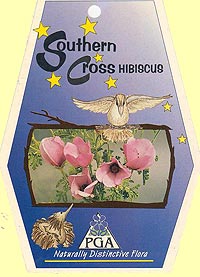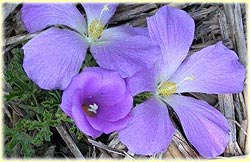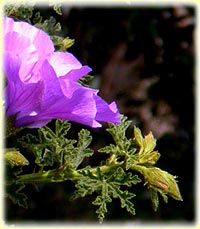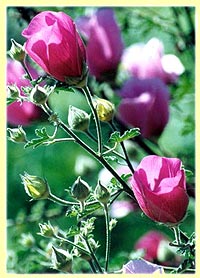 |
| Search this site: |
Alyogynes in the Sub-tropics. Selected species and Crosses
Written for the Association of Societies for Growing Australian Plants, Hibiscus and Related Genera Study Group.INTRODUCTION
While we have not had the extended period of knowing and growing Alyogynes that we have had with hibiscus (see March 2008 Newsletter, Issue No. 13), it is about thirty years since we first tried to grow Alyogynes. These initial attempts, in two different gardens, were spectacularly unsuccessful. It wasn’t until we decided to try growing them in pots that we finally had some success. Indeed, this was so successful that I was able to perform the first lot of crosses from plants grown in pots. Even many years later, I kept plants in pots if I wanted to cross species as I had more control over growing and flowering conditions. Some of our species and crosses can be seen in the first illustration. SEE FIGURE 1
 |
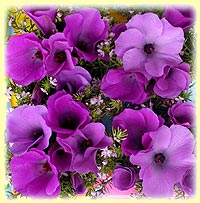 |
 |
| FIGURE 1: Some Alyogyne Species and Crosses | ||
My interest in Alyogynes started both from seeing them flourish in gardens in Melbourne and from finding illustrations in early records of Australian plants (see Appendix). This interest has been furthered by anecdotes and photos from a number of friends growing them in California and in France. While Australian hibiscus have not been widely recognised and have not been widely available either in Australia or overseas, this is not the case for Alyogynes. Some Alyogynes, especially forms of Alyogyne hakeifolia are now available in the nursery trade in Australia and species of Alyogynes and a range of crosses are readily available in U.S.A.
I think that there have been three factors in this success overseas: the blooms last more than one day, there are no prickles and Alyogynes can flower for an extended period.
I am using the names that are still on Alyogyne labels. I am aware of the work done by Dr John Conran with identifying species (see Newsletter 14) but throughout this article, I am using names currently on labels used by nurseries or names used by seed suppliers.
EARLY EXPERIENCES OF ALYOGYNESWe still recall the difficulty in obtaining Alyogynes. Our first plants were purchased while visiting family, from a nursery in Port Macquarie and another in Melbourne (The plants were nursed throughout the plane trip from Melbourne). As we started to have success in growing them, I accessed seed from Australian suppliers and from a friend in Western Australia and found it was easy to grow Alyogynes from seed. In fact, I found that seed which was about 10 years old germinated much more readily than fresher seed.
The early crosses were an attempt to develop a plant that would not drop dead in the humid conditions of a normal Queensland summer. However, before this, I had tried grafting Alyogynes onto a number of rootstocks. The rootstocks were small growing crosses of native hibiscus, e.g. ‘Apricot Mist’ and similar crosses. To my amazement the grafts took and the plants flourished but the plants did not live any longer than those grown in a raised bed with excellent drainage and so I did not pursue the idea of grafting.
PART 1 ALYOGYNE HUEGELIIAround thirty years ago, we found that there were three Alyogynes available. These were Alyogyne huegelii, the species form with a beautiful lilac bloom, Alyogyne “West Coast Gem” and a pink Alyogyne with a tulip-shaped bloom. This was available with a label “Alyogyne heugelii pink”, “Southern Cross Hibiscus”. The label described the plant as “Australia’s very own native hibiscus’. SEE FIGURE 2
ALYOGYNE HUEGLII CROSSES
We realised that if I wanted plants that coped with our conditions, planned crosses would be necessary. Of the three species initially available, the Alyogyne huegelii plant with the lilac bloom had a short life. The fragile blooms crowded the plant and gave the appearance of a cloud of butterflies floating above the bush. While Alyogyne “West Coast Gem” has a more substantial bloom, the bush is subject to wind damage and has never been long-lived in our conditions. This plant is the earliest to bloom, an important consideration when considering crosses. Also of importance for crosses is the shape of the flower. The petals overlap and the bloom retains this overlapping feature, unlike the species which can have petals that spread as the bloom ages (shown in Fig. 2). The third available plant was quite different. SEE FIGURE 3
 |
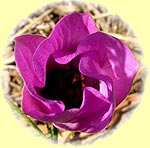 |
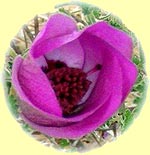 |
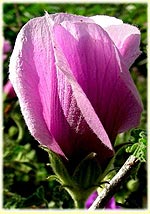 |
| FIGURE 3: Alyogyne huegelii pink tulip form | |||
In fact, the deep mauve-pink flowers of what was then called Hibiscus huegelii var. leptochlamys were noted by Hill (1). These flowers are quite different from either the species or A. “West Coast Gem”. The shape is different, being like a tulip and the stigma pads are not white as in the other two plants but are dark. At first, I thought this bloom was not as good as the more open blooms of the other two Alyogynes but I came to realize that the tulip-shaped bloom was attractive in its own right. It had one special feature that I had not detected in the others, the bloom is perfumed. More importantly, this plant seemed to live longer than the other two plants.
All three of these plants flower prolifically here but over a short period, mainly spring. Possibly the best aspect of these three initial plants, was that they did not all flower together. Alyogyne “West Coast Gem” started flowering in winter. It was followed by Alyogyne huegelii, lilac flowering form in early spring and then later in spring, the pink tulip-shaped Alyogyne started to bloom.
The first cross was between the lilac-flowering species and the pink tulip-shaped form. Over 40 seedlings grew from this cross. All that were kept to flowering stage had dark stigma pads, purple for Alyogyne “Patricia Noble” and bright pink for all others, including Alyogyne “Christopher Noble”. The colour of all seedlings was vibrant, with more intensity than either of the parents. A number of these crosses were retained and are still doing well. There is a range of heights, with plants of Alyogyne “Patricia Noble” and Alyogyne "Karana" reaching about 1.5 metres while others such as Alyogyne “Carole’s Choice” can be up to two or more metres in height. SEE FIGURE 4
 |
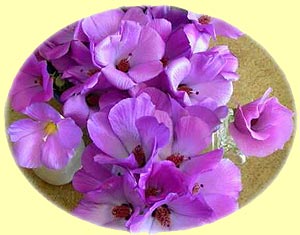 |
| FIGURE 4: Cross between Alyogyne huegelii, lilac bloom and A. huegelii pink tulip bloom | |
FAQs | Links | Contact Us | Privacy Policy
Copyright © 2000-2011 hibiscus.org All rights reserved.
Featuring a selection of classic hymns performed on piano and organ, with lyrics, free for reuse


